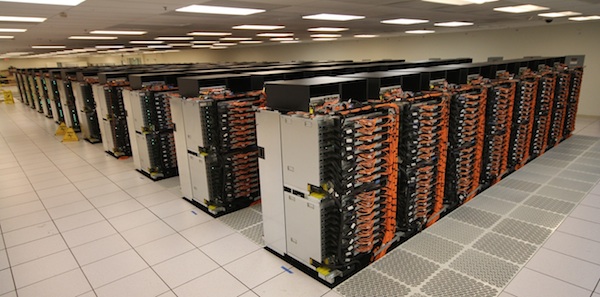US beats Japan in Top500 battle for most powerful supercomputer

The US has overtaken Japan to become home of the world's most powerful supercomputer, after an IBM-based Sequoia system trounced the Japanese K Computer.

The IBM Blue Gene/Q supercomputer at the Lawrence Livermore National Laboratory has topped the last Top500 supercomputing list. Image credit: Top500
Sequoia, an IBM Blue Gene/Q supercomputer at the Lawrence Livermore National Laboratory, reached 16.32 petaflops, while previous leader K Computer trailed with 10.5 petaflops, according to the Top500 list. The list was published on Monday at the International Supercomputing Conference in Hamburg.
The latest edition of the list, which is published twice a year, shows that Intel is slipping and IBM is recapturing lost ground, while the US is back on top after losing its lead three years ago. New technologies reign, from updated chips from IBM to a build of Fujitsu's novel interconnect product.
"Supercomputing very much is a technology market... where new technologies come from the top and trickle down," Erich Strohmaier, the head of the future technology group at the Lawrence Livermore, said in a keynote speech at the Hamburg conference. "The new stuff — as soon as we have confidence that it works, it gets introduced in a very large system."
Intel processors appeared in 372 systems in the June list — 74.4 percent of the total — down from 384 in the November 2011 rankings. Meanwhile, IBM has increased its share from 49 to 58 systems, an 11.6-percent rise.
Intel's position
A look at the rankings shows Intel in a tricky position. The top trio of systems were based on non-x86 chips, with first and third place going to machines that run on IBM's Power and second place on Fujitsu's SPARC. Intel's highest-ranking computer, the German Xeon-based SuperMUC, achieved only 2.8 petaflops, a far cry from the 16.32, 10.5 and 8.1 of the systems above it.
Four of the top 10 systems were based on Intel Xeons, reaching fourth, fifth, ninth and 10th place. That compares with second, fourth, fifth and seventh in the preceding Top500 list.
One bright spot for Intel is its Many Integrated Core (MIC) processor. This made its first appearance on the list this year in a prototype Intel system named 'Discovery', which came in at 118 teraflops. Though this system reached a relatively low position, it was the third most energy-efficient system in the entire list, with much of that efficiency coming from the MIC, Strohmaier said.
While the US is the overwhelming leader among countries in the list — it is home to 253 of the Top500 — Europe managed to inch up from 103 systems to 107, third after the US and Asia (121 systems).
The highest-ranking UK system came was the Science and Technology Facilities Council's IBM Blue Joule system, which reached 13th place with 1.2 petaflops. Supercomputers from the University of Edinburgh, the Metrological Office, and the European Centre for Medium-Range Weather Forecasts also made the top 50.